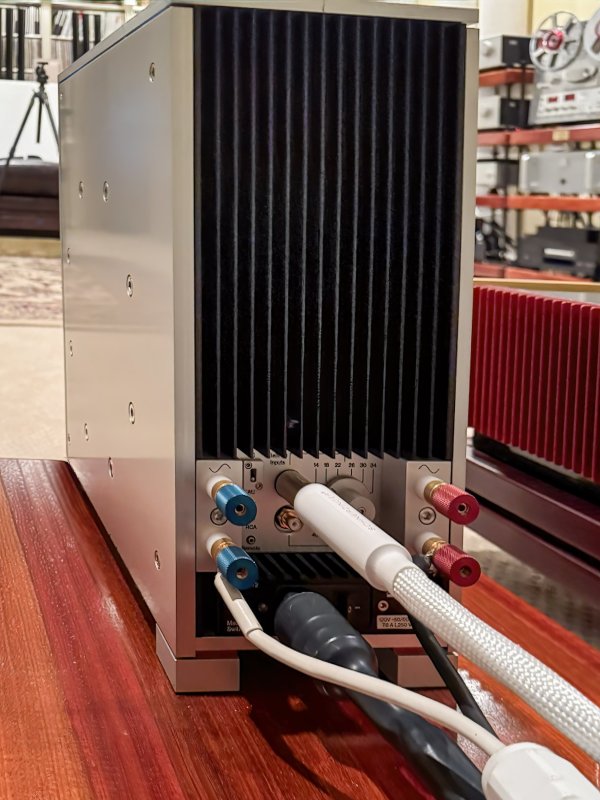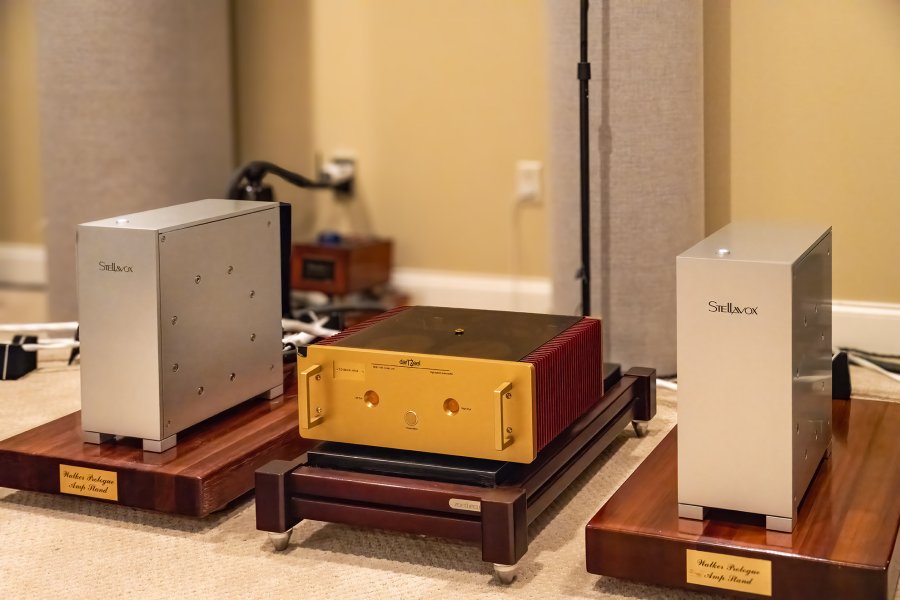Design and Aesthetics
The Stellavox IDEM is surprisingly compact, notably smaller than I anticipated from photos, standing approximately 16 inches high and 7 inches wide. While it exudes Swiss precision in its build, it is not a statement-making visual presence like components from D’Agostino, Gryphon, or darTZeel. A minimalist aesthetic is maintained with a single, multi-function on/off button/indicator light on the top panel. The majority of the rear is devoted to a substantial heat sink, which is necessary given that the unit runs quite warm, registering over 130+ F at the heat sinks once it reaches its stable operating temperature after approximately one to two hours. The rear panel also features robust and secure speaker binding posts distinguished by unusual blue and red coloration, and a gain control, which was set to its minimum position for all initial listening. Visually understated, the IDEM's "Clark Kent exterior" belies a truly special and, in my estimation, groundbreaking amplifier.
Realism and Emotional Engagement
Echoing the initial observations by Myles Astor, the IDEM's core strength lies in its ability to deliver an unmatched sense of realism. With reference-quality recordings, the amplifier allows the listener to suspend disbelief, creating the rare and fleeting sensation that the musical event is physically occurring in the room. This "goosebump factor" is intensely emotional, transforming listening into an intimate, visceral experience. With a variety of well recorded sources - including Ed Pong’s tape of violinist Tatsuki Nurita, Miles Davis's Kind of Blue (tape), Laurie Lieberman's Truly (vinyl), and Greg Brown’s Poets Game (vinyl) - the IDEM consistently delivered timbral accuracy and purity that made the performers appear briefly present.
Transparency
Gideon has stressed their lack of inherent sonic character, a claim my listening tests confirmed. Unlike most components which in my opinion, possess a definable "sound" (be it "forward," "laid-back," "top-down," etc.), the IDEM defied initial attempts at sonic categorization. Having recently had Goldmund, Tenor, darTZeel and several Soulution amps in my system, each delivered a different “sound.” Conversely, the IDEM is unique in its lack of “sound” personality. Early listening led to a moment of concern, fearing a potential top-end roll-off or lack of deep bass. However, as the music’s complexity and dynamic range expanded, the amplifier simply mirrored the music, blooming into a compelling aural narrative. At times they remind me of pure class A amplifiers – but with speed, drive and PRaT. While I am certainly not an engineer, but perhaps the lack of op amps and lack of feedback combined with extreme high current could be part of the magic.
And if you are wondering, yes, they can rock and shake the foundation. See my You Tube video.
The IDEM in my system
The IDEM serves as a clear, uncolored window into the recording, reflecting everything thrown at it, from the delicate articulation of Tatsuki Nurita’s violin to the bombastic conclusion of Led Zeppelin's "Stairway to Heaven," without imposing a singular sonic fingerprint. This level of transparency recalls the memory of my legendary Tenor OTL 75 amplifiers - a device that, until now, held the gold standard in my experience for "removing the veils" and revealing spectacular detail and nuance.
While not an OTL clone, the IDEM achieves a similar purity and freedom from phase-induced distortions. Its transparency allows for precise, deep, and layered imaging, revealing the subtle interplay between instruments and capturing low-level information that is typically lost or blurred. However, unlike the sonic profile of classic OTL designs, the IDEM pairs this purity with an immensely powerful, textured, and well-defined low end. With the ability to deliver 700 watts into a 2 Ω load, the amp offers virtually unlimited power, current, and stability. In summary, as Gideon has noted, the IDEM sound can be conceptualized as merging the purity of an OTL or Triode with the mid-range transparency of the original Quad ESL-57.
Immersion and Intimacy
My typical metrics for emotional engagement—including freedom from listening fatigue and the "goosebump effect"—were spectacularly satisfied. Marathon listening sessions (up to six hours) left me exhilarated, not drained. Listening becomes immersive and intimate - less an act of passively hearing music and more a focused, exclusive experience of the performance.
The IDEM's presentation is direct and emotionally engaging. It allows the listener to delve deep into the mix, not through artificial resolution enhancement, but by rendering the natural interplay between notes, musicians, and the subtleties of the production. Having heard familiar recordings literally hundreds of times, the discovery of new textures and low-level information is astonishing.
Initial Conclusion
The Stellavox IDEM’s sound is transparent with no intrinsic character representing a significant shift from components designed to offer a more "exciting," "warm," or "lush" sonic signature. For me, who previously voiced my system toward an "exciting musical involvement," the IDEM is a profound change, offering a clear window that is musically involving precisely because of its unparalleled accuracy and transparency.
More to come as I get a better handle on the amps.


The Stellavox IDEM is surprisingly compact, notably smaller than I anticipated from photos, standing approximately 16 inches high and 7 inches wide. While it exudes Swiss precision in its build, it is not a statement-making visual presence like components from D’Agostino, Gryphon, or darTZeel. A minimalist aesthetic is maintained with a single, multi-function on/off button/indicator light on the top panel. The majority of the rear is devoted to a substantial heat sink, which is necessary given that the unit runs quite warm, registering over 130+ F at the heat sinks once it reaches its stable operating temperature after approximately one to two hours. The rear panel also features robust and secure speaker binding posts distinguished by unusual blue and red coloration, and a gain control, which was set to its minimum position for all initial listening. Visually understated, the IDEM's "Clark Kent exterior" belies a truly special and, in my estimation, groundbreaking amplifier.
Realism and Emotional Engagement
Echoing the initial observations by Myles Astor, the IDEM's core strength lies in its ability to deliver an unmatched sense of realism. With reference-quality recordings, the amplifier allows the listener to suspend disbelief, creating the rare and fleeting sensation that the musical event is physically occurring in the room. This "goosebump factor" is intensely emotional, transforming listening into an intimate, visceral experience. With a variety of well recorded sources - including Ed Pong’s tape of violinist Tatsuki Nurita, Miles Davis's Kind of Blue (tape), Laurie Lieberman's Truly (vinyl), and Greg Brown’s Poets Game (vinyl) - the IDEM consistently delivered timbral accuracy and purity that made the performers appear briefly present.
Transparency
Gideon has stressed their lack of inherent sonic character, a claim my listening tests confirmed. Unlike most components which in my opinion, possess a definable "sound" (be it "forward," "laid-back," "top-down," etc.), the IDEM defied initial attempts at sonic categorization. Having recently had Goldmund, Tenor, darTZeel and several Soulution amps in my system, each delivered a different “sound.” Conversely, the IDEM is unique in its lack of “sound” personality. Early listening led to a moment of concern, fearing a potential top-end roll-off or lack of deep bass. However, as the music’s complexity and dynamic range expanded, the amplifier simply mirrored the music, blooming into a compelling aural narrative. At times they remind me of pure class A amplifiers – but with speed, drive and PRaT. While I am certainly not an engineer, but perhaps the lack of op amps and lack of feedback combined with extreme high current could be part of the magic.
And if you are wondering, yes, they can rock and shake the foundation. See my You Tube video.
The IDEM in my system
The IDEM serves as a clear, uncolored window into the recording, reflecting everything thrown at it, from the delicate articulation of Tatsuki Nurita’s violin to the bombastic conclusion of Led Zeppelin's "Stairway to Heaven," without imposing a singular sonic fingerprint. This level of transparency recalls the memory of my legendary Tenor OTL 75 amplifiers - a device that, until now, held the gold standard in my experience for "removing the veils" and revealing spectacular detail and nuance.
While not an OTL clone, the IDEM achieves a similar purity and freedom from phase-induced distortions. Its transparency allows for precise, deep, and layered imaging, revealing the subtle interplay between instruments and capturing low-level information that is typically lost or blurred. However, unlike the sonic profile of classic OTL designs, the IDEM pairs this purity with an immensely powerful, textured, and well-defined low end. With the ability to deliver 700 watts into a 2 Ω load, the amp offers virtually unlimited power, current, and stability. In summary, as Gideon has noted, the IDEM sound can be conceptualized as merging the purity of an OTL or Triode with the mid-range transparency of the original Quad ESL-57.
Immersion and Intimacy
My typical metrics for emotional engagement—including freedom from listening fatigue and the "goosebump effect"—were spectacularly satisfied. Marathon listening sessions (up to six hours) left me exhilarated, not drained. Listening becomes immersive and intimate - less an act of passively hearing music and more a focused, exclusive experience of the performance.
The IDEM's presentation is direct and emotionally engaging. It allows the listener to delve deep into the mix, not through artificial resolution enhancement, but by rendering the natural interplay between notes, musicians, and the subtleties of the production. Having heard familiar recordings literally hundreds of times, the discovery of new textures and low-level information is astonishing.
Initial Conclusion
The Stellavox IDEM’s sound is transparent with no intrinsic character representing a significant shift from components designed to offer a more "exciting," "warm," or "lush" sonic signature. For me, who previously voiced my system toward an "exciting musical involvement," the IDEM is a profound change, offering a clear window that is musically involving precisely because of its unparalleled accuracy and transparency.
More to come as I get a better handle on the amps.



